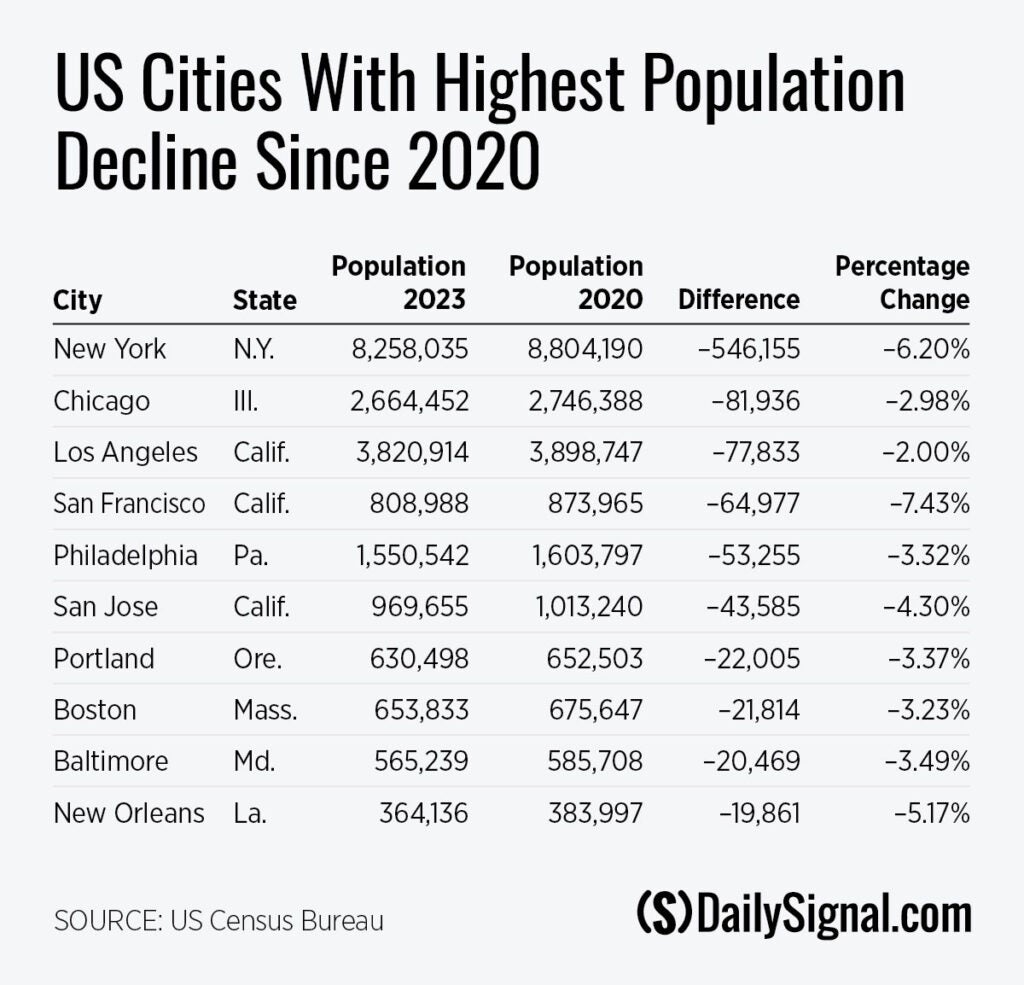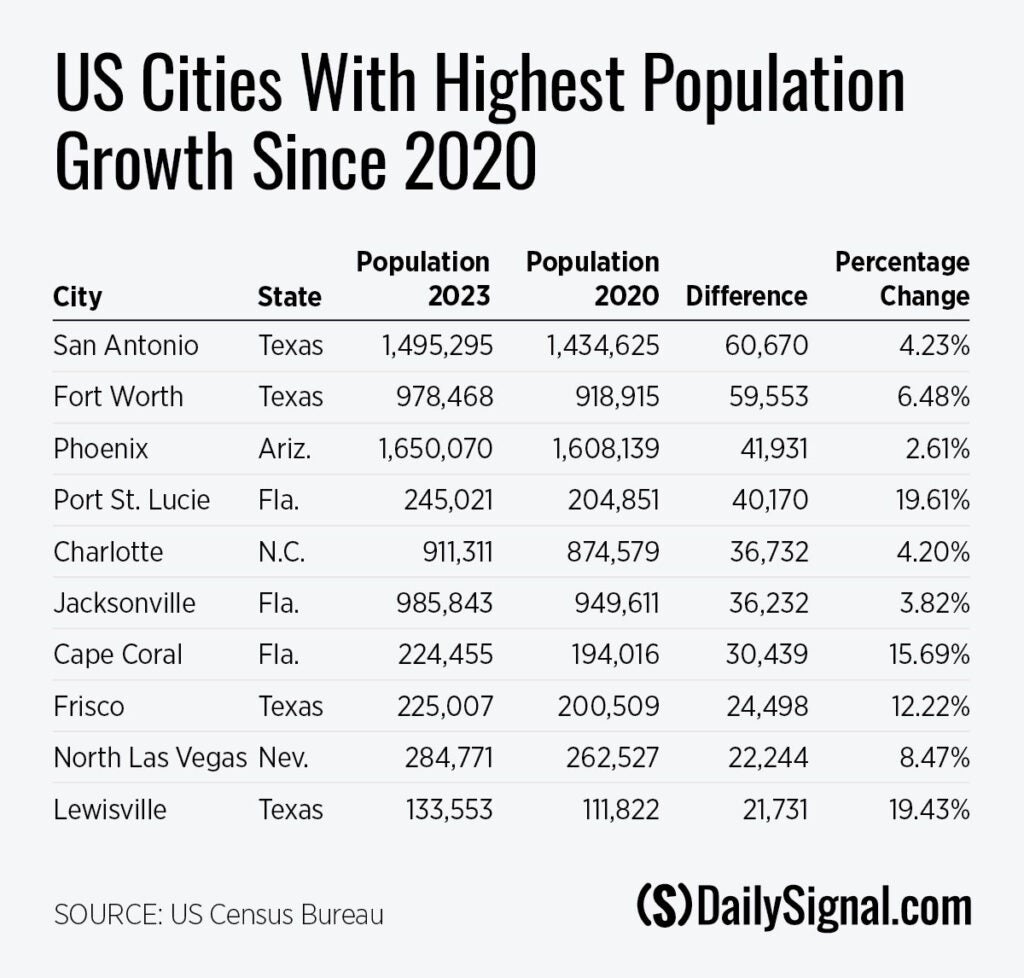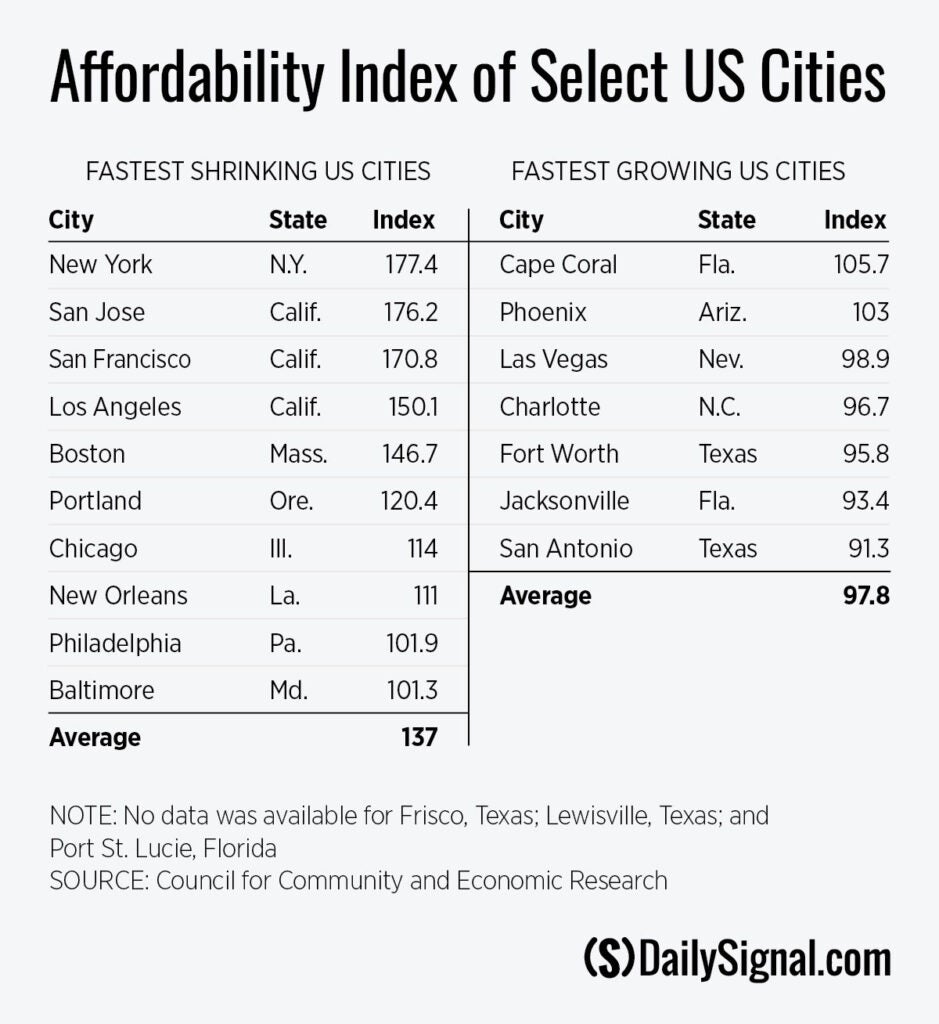Once magnets for opportunity and growth, cities such as New York, Chicago, and Los Angeles are now experiencing a significant population exodus.
The latest census data reveals that some of the United States’ most prominent cities are losing residents by the thousands, while less known cities such as Port St. Lucie, Florida, and Lewisville, Texas, are gaining.
This trend has not always been the case. America’s flagship cities generally provide abundant job opportunities, a wide array of events and entertainment, superior dining options, and better schools and universities. But despite these appealing qualities, certain factors are driving the current demographic shift away from these cities.
The Daily Signal depends on the support of readers like you. Donate now
What are the primary reasons behind this trend? The data shows it is closely tied to state and local government policies, which have worsened the nation’s most notable cities’ crime rates, cost of living, and tax burdens.
As a result, Americans are relocating to safer and more affordable places.


These tables highlight the top 10 cities with the greatest population decline or growth since 2020. A broader trend emerges of cities in Texas and Florida gaining residents, while cities in California and other large metropolitan areas are losing population.
Three primary factors explain this demographic shift.
Crime
Rising crime rates, especially in cities with policies that embolden criminals, are pushing residents away.
The Heritage Foundation’s report, “The Blue City Murder Problem,” highlights the role of lax prosecutors in imposing policies that have led to rampant crime.
For instance, San Francisco reported a staggering 3,384 thefts from vehicles (larceny) in September 2022 alone. Other cities, such as Baltimore and New Orleans, have homicide rates of 51.1 and 40.6 per 100,000 residents, respectively, making them the second- and third-deadliest cities in the U.S.
Consequently, residents of these cities have fled to safer areas where the rule of law is upheld.
The “defund the police” movement has also contributed to crime spikes. That policy is wildly unpopular with the American public: A Pew Research poll indicates that only 15% of adults want police spending to decrease, while 47% want it to increase.
Despite such polls, research by the Judiciary Committee shows that cities such as Baltimore, Los Angeles, New York, Philadelphia, and San Francisco cut a total of $1.35 billion in police spending following the Black Lives Matter riots of 2020.
The consequences have been severe.
Major felony offenses in New York City increased from about 95,000 in 2019 to 102,000 in 2021 and hit a citywide record of 126,700 in 2023. Philadelphia, another city that decreased its police spending, saw homicides spike from 353 in 2019 to 499 in 2020, reaching a record high of 562 in 2021.
Instead of making their communities safer, local politicians have created environments where criminals face little risk of prosecution.
Cost of Living
Crime isn’t the only culprit. The rising cost of living is also pushing residents out. For instance, the median home price in Los Angeles in April was $1.2 million, compared to Fort Worth, Texas, where the median home price is a much more manageable $355,000.
The average median home-price listing in the top 10 shrinking-population cities was $716,070, compared with $445,900 for the top 10 fastest-growing cities.
High home prices make it hard for people to buy a home, so they settle down in cities where homeownership can become a reality.
The overall cost of living should also factor in grocery, transportation, and utility costs. Data from the Council for Community and Economic Research allows for “apples-to-apples” comparisons between cities, using an index where the U.S. average affordability has a value of 100.

The data shows a clear pattern: Cities losing population are unaffordable, while affordable cities such as Jacksonville, Florida, and San Antonio, Texas, are gaining new residents.
With the cost of living increasing nationwide, Americans are not looking to exacerbate this burden by moving to expensive cities.
Taxes
Taxes also play a crucial role in these migrations.
Nine U.S. states, including Texas, Florida, and Nevada, do not have a state income tax. Notably, eight of the 10 fastest-growing cities are in those states. In contrast, none of the top 10 cities with the greatest population decline are in states without an income tax.
A measure known as the “State-Local Effective Tax Rate” provides a clear comparison of state-specific tax burdens.
New York ranks highest with an effective tax rate of 15.9%, while California ranks fifth at 13.5%. Conversely, Texas and Florida have much lower rates at 8.6% and 9.1%, respectively. This data indicates that Americans are favoring cities in states with more tax-friendly policies.
Conclusion
When local politicians focus on making their communities safe and affordable while keeping taxes low, residents respond by moving in.
On the other hand, cities that fail to address high crime rates, rising living costs, and heavy tax burdens are witnessing significant population declines.
This exodus not only diminishes the tax base, but also discourages new businesses and investments, perpetuating a cycle of economic challenges.
Unless these cities recognize the urgency of these issues and implement effective policies to reverse these trends, they will continue to lose residents to more favorable environments.
The demographic shifts we are witnessing today highlight the critical need for effective governance that prioritizes safety, affordability, and fiscal responsibility.






























